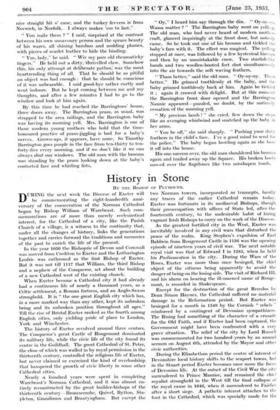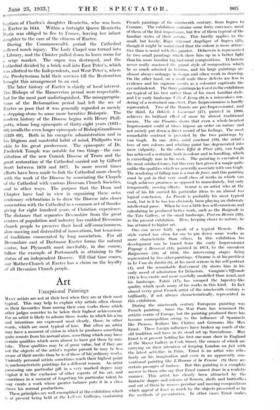History in Stone By
THE BISHOP OF PLYMOUTH.
DURING the next week the Diocese of Exeter will be commemorating the eight-hundredth anni- versary of the consecration of the Norman Cathedral begun by Bishop William of Warelwast. Such corn- ineinorations are of more than merely ecclesiastical interest, for the Cathedral of a city, like the Parish Church of a village, is a witness to the continuity that, under all the changes of history, links the generations together and carries forward the traditions and memories of the past to enrich the life of the present.
In the year 1050 the Bishopric of Devon and Cornwall was moved from Creditors to Exeter and the Lotharingian Leofric was enthroned as the first Bishop - Of Exeter. But it was not till 1117 that William, the third Bishop and a nephew of the Conqueror, set about the building of a new Cathedral west of the existing church.
When Exeter became a Cathedral city it had already had a continuous life of nearly a thousand years, as a Celtic settlement, a Roman fortress, and an Anglo-Saxon stronghold. It is " the one great English city which has, in a more marked way than any other, kept its unbroken being and its unbroken position throughout all ages." Till the rise of Bristol Exeter ranked as the fourth among English cities, only yielding pride of place to London, York and Winchester.
The history of Exeter revolved around three centres. The Conqueror's great Castle of Rougemont dominated its military life, while the civic life of the city found its centre in the Guildhall. The great Cathedral of St. Peter, the close of which was walled in by royal permission in the thirteenth century, controlled the religious life of Exeter, but never claimed or exercised the kind of overlordship that hampered the growth of civic liberty in some other Cathedral cities.
Nearly a hundred years were spent in completing Warelwast's Norman Cathedral, and it was almost en- tirely reconstructed by the great builder-bishops of the. thirteenth century7-Bronescombe. , Quivel, Bytton, Sta- pleton, Graiidision and Brantyngham. But except the two Norman towers, incorporated as transepts, hardly any traces of the earlier Cathedral remain today. Exeter was fortunate in its mediaeval Bishops, though their preoccupation with offices of State led, after the fourteenth century, to the undesirable habit of hiring vagrant Irish Bishops to carry on the work of the Diocese.
As the greatest fortified city in the West, Exeter was inevitably involved in any civil wars that disturbed the peace of the realm. King Stephen's expulsion of Earl Baldwin from Rougemont Castle in 1136 was the opening episode of nineteen years of civil war. The next notable royal visit was that of Edward I in .1285, when lie held his Parliamodum in the city.. During the Wars of the Roses, Exeter was more than once besieged, the chief object of the citizens being apparently to avoid the danger of being on the losing side. The visit of Richard III, and his alarm on hearing the ill-omened name of Rouge- mont, is recorded in Shakeipeare.
Except for the destruction of the great Reredos by Dean Simon Haynes, the Cathedral suffered no material damage in the Reformation period.. But- Exeter was besieged for a month in 1549 by the Cornish " rebels " reinforced by a contingent of Devonian sympathizers. The Rising hid something of the character of a crusade for the Old Faith, and if Exeter had been captured, the Government might have been confronted with a very grave situation. The relief of the city by-Lord Russell was commemorated for two hundred years by an annual sermon on August 6th, attended by the Mayor and other civic authorities.
During the Elizabethan period the centre of interest of Devonshire local history shifts to the seaport towns, but in the Stuart period Exeter becomes once more the focus of Devonian life. At the outset of the Civil War the city surrendered to Prince Maurice, and:remained the chief royalist stronghold in the West till the final collapse of the royal cause in 1646, when- it surrendered -to Fairfax after a 'short siege. A pathetic interest attaches to the font in the Cathedral, which Was specially made kir the baptism of Charles's- daughter Henrietta, who was born in Exeter in 1644. - Within -a fortnight Queen -Henrietta Maria was obliged to flee to France, leaving her infant daughter to the care of the citizens of Exeter.
During the Commonwealth period the Cathedral suffered much injury. The Lady Chapel was turned into a Library, and the Cloister pulled down to leave room for a serge market. The organ was destroyed, and the Cathedral divided by a brick wall into East Peter's, which was allotted to the Independents, and Wet Peter's, where the Presbyterians held their services till the Restoration brought this arrangement to an end.
The later history of Exeter is chiefly of local interest.
• The Bishops of the Hanoverian period were respectable, but for the most part undistinguished. The misappropria- tions of the Reformation period had left the see of Exeter so poor that it was generally regarded as merely a stepping-stone to some more lucrative Bishopric. The modern -history of the Diocese begins with Henry Phill- potts, whose long episcopate of thirty-eight years (1831- 69) recalls the even longer episcopate of Bishop Grandisson (1320-69). Both in his energetic administration and in . his litigious and masterful habit of mind, Phillpotts was akin to. his great predecessor. The episcopate of Dr. Frederick Temple was notable for two things—the con- - stitution of the new Cornish Diocese of Truro and the great restoration of the Cathedral .carried out by Gilbert Scott • between 1870 and 1877. In more recent times efforts have been made to link the Cathedral more closely with the work of the Diocese by associating the Chapels of the Cathedral with various Diocesan Church Societies, and in other ways. The purpose that the Dean and Chapter have had in view in organizing these octo- centenary Celebrations is to draw the Diocese into closer association with the Cathedral in a common act of thanks- giving for eight hundred years of Christian experience. The distance that separates Devonshire from the great centres of population and industry haS enabled Devonian church people to preserve their local self-consciousness, slow-moving and distrustful of innovations, but tenacious of -traditions consecrated. by long association. For all Devonshire east of Dartmoor Exeter forms the natural centre, but Plymouth must inevitably, in due course, follow the example of Portsmouth in attaining to the status of an independent Diocese. Till that time comes, our Mother-Church at Exeter has a. claim on the loyalty of all Devonian Church people.









































 Previous page
Previous page